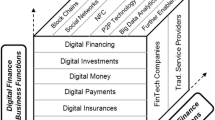Abstract
Internet-based banks use a technology-intensive production process that may benefit from scale effects as they grow larger. This article analyzes whether the predominant Internet-primary bank in the USA generates technology-based economies of scale in the period 2002–2010. There is evidence of both favorable and adverse technology-based scale effects. As the leading Internet-primary bank gets larger, the financial performance gap with traditional banks shrinks while some of its critical competitive advantages wear down. The results suggest that unless the prevailing Internet-primary bank preserves the distinctive advantages of the Internet-based business model as it improves financial performance, it might end up converging with its branching competitors.







Similar content being viewed by others
Notes
We chose a ± 10% range because the resulting sample includes a nearly balanced number of greater (10) and smaller (9) banks than ING Bank. Had we chosen either a narrower or a wider range (e.g., 5% or 15%), the resulting sample would be clearly uneven.
For a recent review see Hsiao (2007).
For details, see Hausman (1978).
References
Arellano M (2003) Panel data econometrics. Oxford University Press, Oxford
Arnold IJM, van Ewijk SE (2011) Can pure play internet banking survive the credit crisis? J Bank Finance 35:783–793
Baltagi BH (2001) Econometric analysis of panel data, 2nd edn. Wiley, New York
Chen SH (2009) Establishment of a performance-evaluation model for service quality in the banking industry. Serv Ind J 29(2):235–247
De Young R (2001) The financial performance of pure play Internet banks. Fed Reserve Bank Chic Econ Perspect 25(1):60–75
De Young R (2005) The performance of Internet-based business models: evidence from the banking industry. J Bus 78(3):893–947
Furst K, Lang W, Nolle D (2002) Internet banking: developments and prospects. Program on information resources policy. Center for Information Policy Research & Harvard University, Cambridge
Gujarati D (2003) Basic econometrics, 4th edn. McGraw Hill, New York
Hausman JA (1978) Specification tests in econometrics. Econometrica 46:1251–1271
Hsiao C (2007) Panel data analysis—advantages and challenges. Test 16(1):1–22
Moore RR (1998) Concentration, technology and market power in banking: is distance dead? Financial industry studies, Federal Reserve of Dallas, December, 1–24
Nadiri H, Kandampully J, Hussain K (2009) Zone of tolerance for banks: a diagnostic model of service quality. Serv Ind J 29(11):1547–1564
Pyun CS (2002) Internet banking in the U.S., Japan and Europe. Multinatl Bus Rev Fall:73–81
Rackley T (2000) Planning is key to cyberbanking success. Bank Syst Technol 37(2):14
Sheshunoff A (2000) Internet banking—an update from the frontlines. ABA Bank J January:51–52
Yousafzai S, Pallister J, Foxall G (2009) Multi-dimensional role of trust in Internet banking adoption. Serv Ind J 29(5):591–605
Acknowledgments
Financial support from the Ministry of Science and Technology of Spain (research project ECO2009-14457-C04-04) is gratefully acknowledged. We thank FUNCAS for its support on a previous version of this manuscript (working paper 630/2011).
Author information
Authors and Affiliations
Corresponding author
Appendices
Appendices
1.1 Appendix 1: Financial performance ratio definitions
-
1.
ROA: return on assets (annualized).
-
2.
ROE: return on book equity (annualized).
-
3.
SPREAD: LOANRATE minus DEPRATE.
-
4.
LOANRATE: interest and fees received on loans divided by total loans (annualized).
-
5.
DEPRATE: interest paid on deposits divided by total deposits (annualized).
-
6.
LOANS: total loans divided by total assets.
-
7.
DEPOSITS: total deposits divided by total assets.
-
8.
FEES: non-interest income divided by total assets (annualized).
-
9.
NIEXP: total non-interest expense divided by total assets (annualized).
-
10.
LABOREXP: salary and benefits expense divided by total assets (annualized).
-
11.
FTES: number of full-time-equivalent employees divided by total assets.
-
12.
WAGE: salary and benefits expense divided by FTES (annualized).
-
13.
PREMEXP: expense on premises and equipment divided by total assets (annualized).
-
14.
OTHEREXP: all “other” (i.e., non-labor and non-premises) non-interest expenses divided by total assets (annualized).
-
15.
OVERHEAD: book value of physical assets divided by total assets.
-
16.
EQUITY: book value of equity divided by total assets.
-
17.
GROWTH: asset growth rate (annualized).
-
18.
BADLOANS: nonperforming loans divided by total assets.
1.2 Appendix 2: Exogenous variables
-
√
%BUSSINESS: commercial and industrial loans divided by total loans.
-
√
%REALSTATE: real estate loans divided by total loans.
-
√
LOANS: total loans.
-
√
LOAN LOSS ALLOWANCE: allowance for loan and lease losses.
-
√
UNEMPLOYMENT: US rate of unemployment.
-
√
QUARTER: seasonal dummy variable.
1.3 Appendix 3
See Table 4.
Rights and permissions
About this article
Cite this article
Momparler, A., Climent, F.J. & Ballester, J.M. The impact of scale effects on the prevailing internet-based banking model in the US. Serv Bus 6, 177–195 (2012). https://doi.org/10.1007/s11628-011-0126-6
Received:
Accepted:
Published:
Issue Date:
DOI: https://doi.org/10.1007/s11628-011-0126-6




